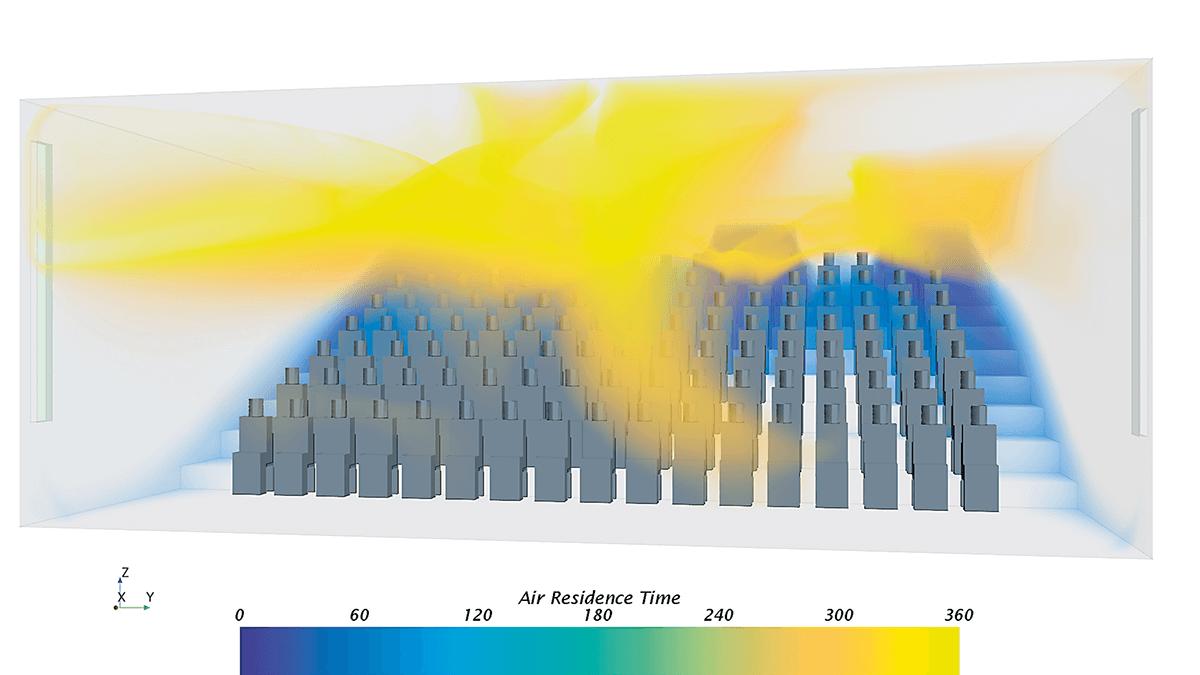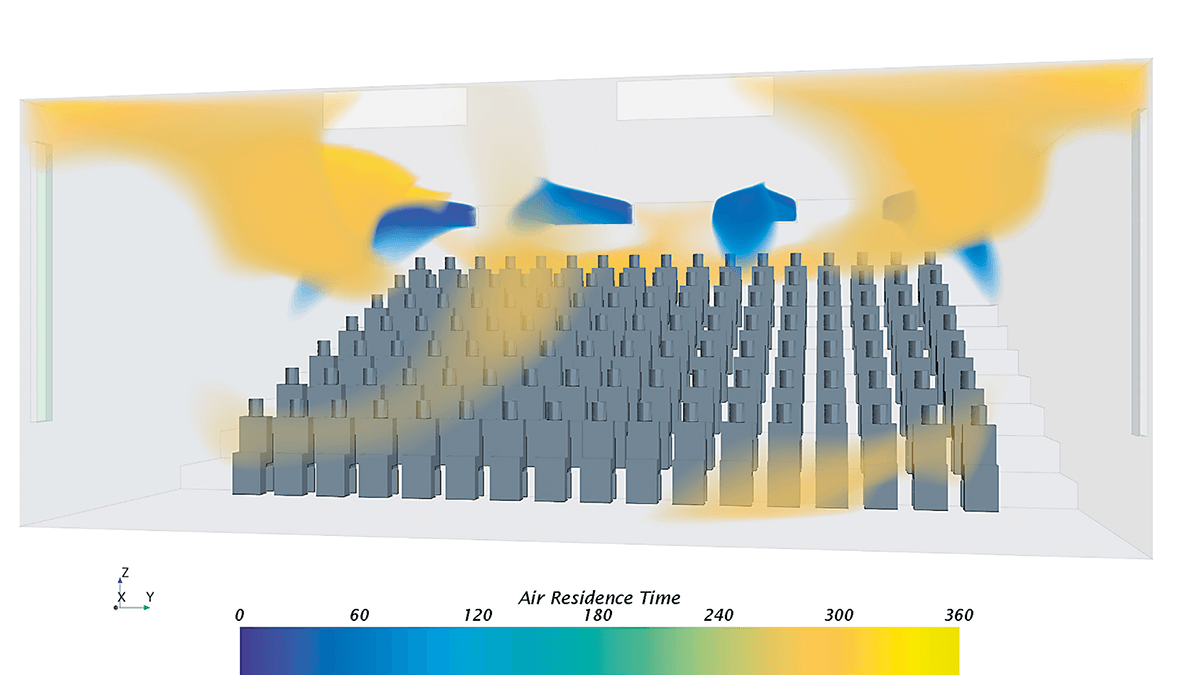12/08/2020
Ventilation simulation
The Washington Post reported on April 25, 2020 that the Covid-19 coronavirus had infected passengers and crew on at least 55 ships, about a fifth of the total global fleet of cruise ships (Washington Post, 2020).
On February 1, 2020, one guest that had travelled for five days on the Diamond Princess tested positive for the coronavirus after disembarkation. On February 4 in Yokohama, ten people onboard tested positive, and the ship was put under quarantine. Over the next month, more than 700 people were infected among 3,711 passengers and crew members on board and for weeks the ship was the site of the largest outbreak outside China (Princess Cruises, 2020) (Mallapaty, 2020).
A study (Mizumoto & Chowell, 2020) on the outbreak on board the Diamond Princess indicates a high transmission potential of the Covid-19 virus inside the confined settings of a cruise ship. The reproduction number, which represents the number of new infections that originate from a single case, is higher in the confined setting than those estimated from communitylevel transmission cases. After the Japanese government implemented an enhanced quarantine control – the passengers were requested to stay inside their cabins – the reproduction number decreased substantially.
Covid-19 transmission
Transmission of infectious diseases can occur through direct contact with infected individuals, indirect contact via fomites, droplet transmission, and aerosolized fine particles (airborne transmission). It is considered that the Covid-19 virus mainly spreads through close contact from person-to-person (CDC, 2020).
Respiratory droplets are produced when an infected person coughs, sneezes, or talks. These droplets can land in the mouths or noses of people who are nearby or possibly be inhaled into the lungs. Large droplets (> 10 μm) formed from coughing and sneezing mostly fall onto surfaces no further than 1–2 m from the infected person. Small particles (< 5 μm) involved in airborne transmission form from respiratory droplets which evaporate and desiccate. The small particles (droplet nuclei) may stay airborne for hours and travel long distances. For the Covid-19 virus, airborne transmission is likely but not yet documented. There is also no reported data or studies to rule out the possibility of the airborne route (REHVA, 2020). Currently, WHO recommends airborne precautions of the Covid-19 virus only for circumstances and settings in which aerosol generating procedures or support treatments are performed (WHO, 2020a).
The faecal-oral transmission routes cannot be excluded as the Covid-19 virus have been detected in stool samples. It was observed during the 2002–2003 SARS outbreak that open connections with sewage systems appeared to be a transmission route in an apartment building in Hong Kong (Yu, et al., 2004). It is also known that flushing toilets create plumes containing droplets and droplet residue when toilets are flushed with open lids (REHVA, 2020).
In addition to the person-to-person transmission, aerosol transmission via central air supply or drainage systems are considered to contribute to the high reproduction number observed during the outbreak on board the Diamond Princess (Zhang, et al., 2020).

Ventilation in infectious disease transmission
By promoting the dilution of room air around a source and the removal of infectious agents, ventilation is used as a primary infectious disease control strategy in hospitals and other facilities. The Federation of European Heating, Ventilation and Air Conditioning Associations (REHVA) has published a guidance document on how to operate and use building services in areas with a coronavirus outbreak to prevent the spread of Covid-19 depending on HVAC or plumbing system related factors (REHVA, 2020).
In relation to the airborne transmission route, REHVA proposes, especially in “hot spot” areas, the use of the ALARA (As Low As Reasonably Achievable) principle and to take measures that help to also control the airborne route in buildings apart from standard hygiene measures (WHO, 2020b). It is recommended, e.g., to increase air supply and exhaust ventilation, to use more window airing, to flush toilets with closed lids, but not to use recirculation. The recommendations should also be applicable in the settings of a cruise ship.
Correia et al. (2020) proposed three hypothetic ways in which, if not correctly used, HVAC systems can contribute to virus transmission through:
- air circulation in confined compartments with infected patients;
- recirculating air in building ventilation systems to different floors/compartments;
- exchanging air with the surroundings if exhaust filtering systems are not adequate.
There are gaps in the knowledge regarding the role of mechanical ventilation in airborne pathogen transmission. As summarized in a review by Luongon et al. (2016), studies showed an association between increased illness and decreased ventilation rate, however, there was insufficient data to quantify how mechanical ventilation might affect the airborne transmission of infectious agents. The authors called for studies to establish causal relationships between airborne exposures and outcomes and between HVAC system factors and exposures. The outbreak on board the Diamond Princess should be within the scope of such studies.
CFD simulation of ventilation and pathogen transmission
CFD has been widely used in HVAC design to ensure optimum health and comfort for occupants in buildings and to meet regulatory requirements. In a HVAC CFD analysis, thermal comfort and air quality indicators such as temperature, relative humidity, pollutant concentration, velocity, and mean age of air, can be investigated.
CFD should also be able to play an important role in the above-mentioned causal relationship studies, and further, in HVAC design to fulfil requirements in preventing airborne pathogen transmission (Aliabadi, et al., 2011). The dispersion of airborne pathogens in ventilation spaces is affected by many variables such as particle size, mean and fluctuating velocities of air, temperature, and the rate at which the particle transfers mass and heat with the environment (i.e., cooling/heating, evaporation). These processes cannot be modelled analytically except in the most idealized cases. The airflow distribution structure in a room can have a major impact on infectious aerosol concentration beyond the simple effect of increased ventilation rate. Detailed CFD simulations would be necessary to study the effect of room envelope conditions, the location of diffusers and exhaust ports, the air exchange rate, and the ventilation strategy used.
The age of air/air residence time can be used to assess the air change effectiveness of the ventilation system in a building (ASHRAE Standard 129-1997). Different ventilation arrangements of a theatre fitted for cruise ships were evaluated at Elomatic with CFD simulations. As shown in Figure 2, the incoming air is from openings at a) the lower part and b) the upper part of the back wall while in arrangement b) there are additional outlets on the front wall. An area with a local air change effectiveness equal or above 0.95, as required by the ASHRAE standard, can be obtained from the simulations. The area that meets this requirement is 20 % larger in arrangement b) than in arrangement a).
Figure 2 also shows areas with the shortest and the longest air residence time, indicating the airflow distribution structure. The blue color indicates shorter air residence time and fresh air while the yellow color indicates the opposite. With arrangement a), there are significant areas with air residence time in the shortest and the longest spectrums. Near the ceiling, there are larger areas with long air residence time, suggesting pockets of circulating air which is less fresh.
With b) arrangement, there are fewer areas with extremely short or long air residence time, indicating a more even distribution of the ventilation air. While a direct link between the air residence time and the risk of airborne pathogen transmission is not established, a comparative analysis is possible. This is so especially or the transmission related to smaller aerosol particles, which tend to closely follow the air flow. Virus-carrying aerosols could be carried away in sufficiently short time from among the audiences, though some could be trapped to the ceiling because of the circulating air. In that respect, arrangement b) with smaller circulating zones would be better.


Figure 2. Areas with the shortest and the longest air residence time in a theatre with
two ventilation arrangements a) and b) – a longer residence time indicates less
fresh air and probable air circulation (pictures and simulations by Atte Rättyä, Niko
Siilin / Elomatic)
During the SARS epidemic in Hong Kong in 2003, there was a large community outbreak in the Amoy Gardens housing complex. In a study on evidence of airborne transmission of the SARS virus, the researchers used CFD to predict the detailed airflow pattern in the air shafts and around the buildings in the housing complex (Yu, et al., 2004). The results of CFD simulations conformed to the epidemiologic analysis and supported the probability of an airborne spread.

from the bathroom of an apartment in building E and moved upwards in the
air shaft. At the top of the air shaft, the plume was blown by wind towards other
buildings (Yu, et al., 2004).
CFD studies have also been carried out during the current pandemic to address the transmission of the Covid-19 virus (Vuorinen, et al., 2020). Researchers from four Finnish research organizations modelled a scenario where a person coughs in an aisle between shelves like those found in grocery stores while taking into consideration the ventilation. In the situation under investigation, the aerosol cloud spreads outside the immediate vicinity of the coughing person and dilutes in the process. The dilution process can take up to several minutes, emphasizing the importance of avoiding busy indoor spaces (Aalto University, 2020).

situation in which a person coughs down a shelf-restricted corridor typical of
grocery stores (picture by Petteri Peltonen / Aalto University) (Aalto University,
2020).
Upon the WHO’s declaration of a pandemic in mid-March, CLIA (Cruise Lines International Association) oceangoing cruise lines voluntarily suspended worldwide operations (Viking Cruises and Princess Cruises suspended their operations prior to that). The suspension will inevitably have a pronounced detrimental effect on the global economy. However, like in many other sectors, the priority is to stop Covid-19. There is a compelling need to have a better understanding of the transmission routes of the Covid-19 virus on board and the way to prevent it.
Elomatic stands fast with our partners in different sectors to face the challenges brought by Covid-19. For the cruise community, we are ready to provide our support to prepare for the recovery, including CFD simulations for the evaluation of ventilation arrangements and the risk of airborne transmission, and assistance in finding solutions to stem the transmission.
Disclaimer
Knowledge of Covid-19 is still forming, hence information in this article, e.g., on the airborne transmission route, could become outdated. Elomatic and the authors are not liable for any direct, indirect, incidental, or any other damages that may result from, or be connected to the use of the information presented in this document.
Sources
- Mallapaty, S. (2020). What the cruise-ship outbreaks reveal about COVID-19. Nature, 580(18). doi:10.1038/d41586-020-00885-w
- Mizumoto, G., & Chowell, G. (2020). Transmission potential of the novel coronavirus (COVID-19) onboard the diamond Princess Cruises Ship, 2020. Infectious Disease Modelling, 5, 264-270.
- Princess Cruises. (2020, February). Diamond Princess Updates – Notices & Advisories. Retrieved May 2020, from https://www.princess.com/news/notices_and_ advisories/notices/diamond-princessupdate.html
- REHVA. (2020). How to operate and use building services in order to prevent the spread of the coronavirus disease (COVID-19) virus (SARS-CoV-2) in workplaces. Federation of European Heating, Ventilation and Air Conditioning Assosiations. Retrieved May 19, 2020, from https://www.rehva.eu/fileadmin/user_ upload/REHVA_COVID-19_guidance_document_ver2_20200403_1.pdf
- Vuorinen, V., Aarnio, M. A., Alava, M., Alopaeus, V., Atanasova, N., Auvinen, M., . . . Kuusela, J. (2020). Modelling aerosol transport and virus exposure with numerical simulations in relation to SARS-CoV-2 transmission by inhalation indoors. Safety Science.
- Washington Post. (2020, April 25). The pandemic at sea. Retrieved May 2020, from https://www.washingtonpost.com/graphics/2020/politics/cruise-shipscoronavirus/
- WHO. (2020a). Modes of transmission of virus causing COVID-19: implications for IPC precaution recommendations. Scientific brief. Retrieved May 19, 2020, from https://www.who.int/news-room/commentaries/detail/modes-of-transmission-of-viruscausing-covid-19-implications-for-ipcprecaution-recommendations
- WHO. (2020b, March 3). getting-workplaceready- for-covid-19.pdf. Retrieved from World Health Organization: https://www.who.int/docs/default-source/coronaviruse/getting-workplace-ready-for-covid-19.pdf
- Yu, I. T., Li, Y., Wong, T. W., Tam, W., Chan, A. T., Lee, J. H., . . . Ho, T. (2004). Evidence of airborne transmission of the Severe Acute Respiratory Syndrome virus. The New England Journal of Medicine, 350, 1731- 1739. doi:10.1056/NEJMoa032867
- Zhang, S., Diao, M., Yu, W., Pei, L., Lin, Z., & Chen, D. (2020). Estimation of the reproductive number of novel coronavirus (COVID-19) and the probable outbreak size on the Diamond Princess cruise ship: A data-driven analysis. International Journal of Infectious Diseases, 93, 201- 204. doi:https://doi.org/10.1016/j. ijid.2020.02.033

